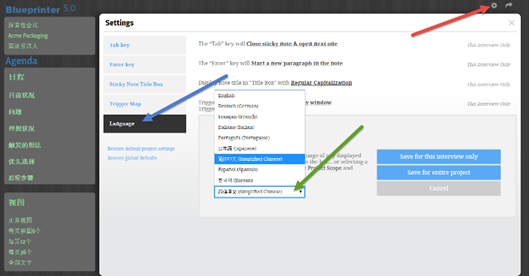You can adjust Blueprinter software to display different languages.
When you are conducting interviews in a country that speaks a different language than you, the bottom line is this: Make them as comfortable as possible. In some cases, they will be entirely comfortable conducting the interview in English (if they are a multi-national company with this as their “common” language). But if there’s any doubt, conduct the interview in their language. Here are some tips for doing so.
- Change the agenda items in the left panel to their language. Click the “Settings” gear (red arrow in illustration). Then click “Language” (blue arrow) and select your desired language (green arrow). This changes all the agenda items on the left to the chosen language.

- Note: You can change the language of agenda items in a Preference interview in the same way as a Discovery interview. In fact, you can change languages for more than the agenda in Preference interviews. You can change all of the fixed text, e.g. "How satisfied are you with your ability to...", the definitions for 1, 3, 5, 7 & 10 ratings, and more.
- You can also use the above language converter feature to change what you call each agenda item. For instance, some cultures don’t want to talk about their “Problems.” So you might want to rename the yellow sticky notes from “Problems” to “Issues” or “Challenges.”
- Your Note-taker should be able to type customer comments in the sticky notes in their local language. And your Moderator should be able to converse in their language as well. Keep in mind, that one or both of these people can do their work remotely, using a web-conference.
- If one or more of your interview colleagues doesn't speak the local language, put a few summary words at the end of each sticky note in a language they do understand (e.g. English) to help them follow along during the interview. Then give these colleagues the chance to periodically ask any questions they may have.
- For projects being managed by a global team, consider translating Outcome Statements and key sticky notes into a common team language (e.g. English) when debriefing after the Discovery Interview.
Of course, conducting an interview in a different language will always have its challenges. But consider this: Most people asked to participate in an unfamiliar language find it easier to read the unfamiliar language than speak or listen to it. So the highly visual nature of Discovery interviews can be quite helpful.
Keywords: different language, Discovery in other language, convert language, display different language, language converter, convert language in Discovery Noteboard
